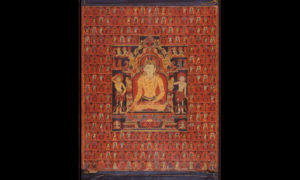Feb 14, 2014
Tibetan masterpieces configured to create a three-dimensional meditation map.
Download a PDF copy of this Press Release

SAN FRANCISCO, Feb. 14, 2014— Mandalas are geometric maps of Himalayan Buddhist visionary worlds, created by and for practitioners of Vajrayana Buddhism (“Lightning Vehicle” Buddhism), a system of meditation that is profoundly dependent on art and artists. Minutely detailed and saturated with philosophical meaning, these mandalas (most often paintings or sculptures) are a feast for the eyes and the mind.
Beginning March 14, the Asian Art Museum will configure 15 artworks from the museum’s collection to transform its Tateuchi Gallery into a three-dimensional mandala for the special exhibition Enter the Mandala: Cosmic Centers and Mental Maps of Himalayan Buddhism. On view through Oct. 26, Enter the Mandala creates a mandala that can be entered physically, which is one goal of Lightning Vehicle meditation itself. Museum visitors who “enter the mandala” will get a virtual taste of what it might be like to find oneself inside its nested geometries.
For Buddhist practitioners, mandalas are not just images to view, but worlds to explore—after recreating the image in their mind’s eye, meditators imaginatively enter its realm. A mandala’s basic form can be described as a quincunx, a center surrounded by four symbolic directions, like the five spots on a dice. In Lightning Vehicle Buddhism, each direction is presided over by a color-coded Buddha, each of whom represents a psychological defect (pride, delusion, frustration, hatred and lust) and the means of its transformation into fuel for enlightenment. By reciting the verbal formula (mantra) and forming the hand gesture (mudra) of the Buddha who epitomizes a practitioner’s characteristic defect, the meditator transforms that defect into a corresponding insight.
In Enter the Mandala, a series of mandala paintings align the gallery with the cardinal directions—north, south, east and west—transforming the open gallery space into an architectural mandala. Three of these paintings are richly detailed and red-toned in the Nepalese style; they were originally part of a set of five paintings. These three works—all in the Asian Art Museum’s collection—form what is perhaps the most complete set of its kind outside of Tibet.
Each of the five paintings portrays one of the five cosmic Buddhas. In the southern sector of the mandala, the first of the original paintings—portraying the yellow Buddha Ratnasambhava—represents the transformation of pride into an intuition of equality. In the center of the mandala, the second painting depicts the white Buddha Vairochana, responsible for transforming delusion into knowledge of reality. The northern sector features the third painting, the green Buddha Amoghasiddhi, who transforms frustration into success. In the eastern sector, the blue Buddha Akshobhya, who transforms hatred into wisdom, is represented by a photo reproduction from the Honolulu Museum of Art’s eastern mandala. The whereabouts of the set’s original painting for the western sector remains a mystery. For this exhibition, the red Buddha of the west, Amitabha, appears in a 14th-century Japanese painting and transforms lust into insight.
At the center of this gallery stands a symbolic replica of the Svayambhu Stupa, perhaps the best-known example of a monumental Lightning World mandala today. Stupas—monuments created to enshrine the sacred remains of enlightened beings—originated in India as mounds for marking sacred sites or containing religious relics. In Lighting Vehicle Buddhism, the stupa’s architecture echoes the basic form of a mandala, with a central axis surrounded by four directions. Visitors can find other artworks related to Lighting Vehicle Buddhism on the museum’s Lighting Path gallery tour.
Enter the Mandala Event
First Thursdays
ChimaTek™: Hybridity Visualization Mandala
Thursday, September 4, 6–9 p.m.
Museum-wide, free with admission ($5 after 5 p.m.)
In conjunction with the exhibition Enter the Mandala: Cosmic Centers and Mental Maps of Himalayan Buddhism, the museum presents a newly commissioned performance by visual artist Saya Woolfalk, which will be developed during her residency at Headlands Center for the Arts. The artist’s work encompasses sculpture, textiles, painting, video and performance art while drawing from anthropology, mythology and science fiction to explore notions of hybridity and utopia. Woolfalk will create a new work featuring the Empathics, a fictional group of women who blend racial and ethnic identities as they transform, taking on characteristics of humans and plants. The performance features an original soundtracks composed by Paul D. Miller a.k.a. DJ Spooky that Subliminal Kid. Tonight’s event is presented in collaboration with Headlands Center for the Arts.
Lead funding for the Asian Art Museum’s Thursday Night Programs is provided by Wells Fargo.
The Asian Art Museum–Chong-Moon Lee Center for Asian Art and Culture is one of San Francisco’s premier arts institutions and home to a world-renowned collection of more than 18,000 Asian art treasures spanning 6,000 years of history. Through rich art experiences, centered on historic and contemporary artworks, the Asian Art Museum unlocks the past for visitors, bringing it to life while serving as a catalyst for new art, new creativity and new thinking.
Information: 415.581.3500 or www.asianart.org
Location: 200 Larkin Street, San Francisco, CA 94102
Hours: The museum is open Tuesdays through Sundays from 10 a.m. to 5 p.m. From Feb. 6 through Sept. 11, 2014, hours are extended on Thursdays until 9 p.m. Closed Mondays, as well as New Year’s Day, Thanksgiving Day and Christmas Day.
General Admission: FREE for museum members, $12 for adults, $8 for seniors (65+), college students with ID, and youths (13–17). FREE for children under 12 and SFUSD students with ID. General admission on Thursdays after 5 p.m. is $5 for all visitors (except those under 12, SFUSD students, and museum members, who are always admitted FREE). General admission is FREE to all on Target First Free Sundays (the first Sunday of every month). A surcharge may apply for admission to special exhibitions.
Access: The Asian Art Museum is wheelchair accessible. For more information regarding access: 415.581.3598; TDD: 415.861.2035.